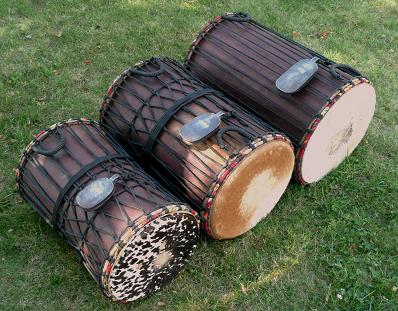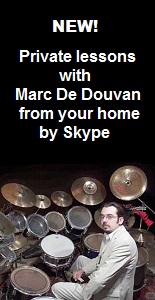
: : : Percussions : : Mandingo : Instruments
The dununs

The dunun is a Mandingo drum played by cylindrical wood bat (big stick). The dununs play the bass parts in the djembes accompanying. But dunun player usually plays also an iron cowbell ("kenken"), at the same time, independently, with a small iron rod, which makes him close to the jazz drummer (ride cymbal and snare drum). The bell is often attached to the shell of dunun, which is placed horizontally on the ground, on a stand or a strap passed over one shoulder.
The dunun is also carved in a tree trunk (such as the djembe) but is cylindrical (deeper than large, a bit like a Brazilian surdo). It has two cow skins (one at each end, as the European drums), and stretched by ropes and iron hoops, such as djembes.
The dununs are usually three, with a different phrase (pattern) by dunun for each polyrhythm. With different size and playing in complementarity (a bit like the three Brazilian surdos), they are somehow the melodic basis, the "theme" of each polyrhythm (which usually develops in eight beats: two 4/4 measures) with the second basic phrase of the djembe (the first being common to all polyrhythms, thus constituting a kind of National Mandingo "mark"). This melodic theme is traditionally associated with a ceremony or an activity, or even an ethnic group or specific social caste (baptism, circumcision, engagement, wedding, harvest, magic, divination, entertainment, dance, welcome, history ("griots": storytellers also keepers in their memory of the history of one or more noble families), theater, virgin women, "masks", clowns, virtuoso dancers, farmers, shoemakers, "fetishors", warriors, leaders, celebrities, kings, etc.).
The low dunun, the largest, is called "Dununba." It is the most important, the one that persists in the distance and fixes the slow and steady basis of the measure, but not necessarily the onbeats (it plays then "offbeat"). The medium dunun is called "sangban" and the smaller, "kenkeni". The bell phrases and bells associated with them (in the same order of size), have the same name.
Dunun players play standing and often use an alternation of muffled strokes (by pressing the bat) or resonant (open), a bit like the Brazilian Surdo players (they always hit their instrument at the center of the skin, unlike djembe players).
The patterns often follow the tonic and bass of the djembes, but never completely, which creates an interlacing feeling proper to the polyrhythms (because it is easier to play and think in unison or in complementary, giving a linear melodic form).
The dunun player often improvised by introducing additional notes or slight variations (a bit like the variations or "breaks" ("fills") of jazz or rock drummers).
Some dunun virtuosos play two dununs at the same time, passing from one to the other and playing the basic phrases of the two, but always with a single bell. Its dununs are sometimes attached in pairs by a rope. The dunun virtuosos are rarely djembe virtuosos, and vice versa, given the differences of playing techniques (like the timbales in relation to the congas in Afro-Cuban music).
Marc De Douvan, October 2005, translation in English: May 2013.
Listen to a rerecording demo played by myself, with an interactive choice of instruments (rhythms or melodies) that you want to hear (published freely on this website on March 2006).
© 2005 Marc de Douvan Crédits Mentions légales
